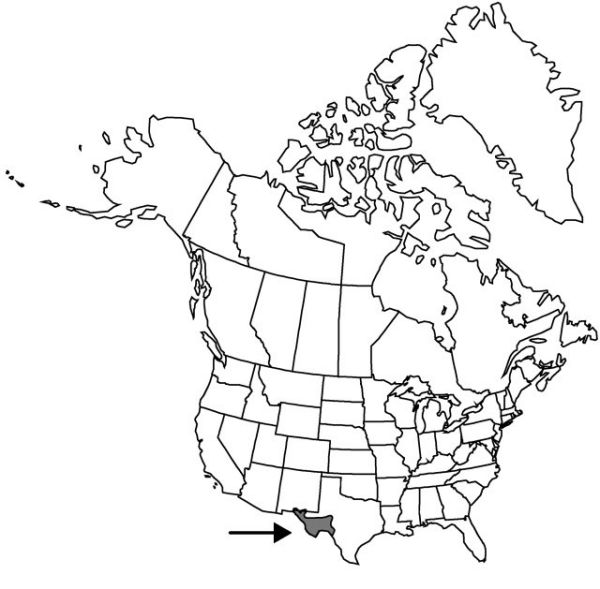Difference between revisions of "Agave lechuguilla"
in W. H. Emory, Rep. U.S. Mex. Bound. 2(1): 213. 1859.
FNA>Volume Importer |
imported>Volume Importer |
||
| (6 intermediate revisions by 2 users not shown) | |||
| Line 1: | Line 1: | ||
{{Treatment/ID | {{Treatment/ID | ||
|accepted_name=Agave lechuguilla | |accepted_name=Agave lechuguilla | ||
| − | |accepted_authority=Torrey | + | |accepted_authority=Torrey |
|publications={{Treatment/Publication | |publications={{Treatment/Publication | ||
|title=in W. H. Emory, Rep. U.S. Mex. Bound. | |title=in W. H. Emory, Rep. U.S. Mex. Bound. | ||
| Line 24: | Line 24: | ||
|elevation=500–1400 m | |elevation=500–1400 m | ||
|distribution=N.Mex.;Tex.;n;e Mexico. | |distribution=N.Mex.;Tex.;n;e Mexico. | ||
| − | |discussion=<p>Agave lechuguilla is the principal source of “istle” or “ixtle,” a hard fiber used for rope and known by the trade name “Tampico fibre.” The plant is poisonous to cattle, goats, and sheep. This species is the dominant agave on the Chihuahuan Desert. It hybridizes with A. havardiana, A. neomexicana, A. gracilipes, and A. ×glomeruliflora.</p> | + | |discussion=<p><i>Agave lechuguilla</i> is the principal source of “istle” or “ixtle,” a hard fiber used for rope and known by the trade name “Tampico fibre.” The plant is poisonous to cattle, goats, and sheep. This species is the dominant agave on the Chihuahuan Desert. It hybridizes with <i>A. havardiana</i>, <i>A. neomexicana</i>, <i>A. gracilipes</i>, and <i>A. ×glomeruliflora</i>.</p> |
|tables= | |tables= | ||
|references= | |references= | ||
| Line 33: | Line 33: | ||
-->{{#Taxon: | -->{{#Taxon: | ||
name=Agave lechuguilla | name=Agave lechuguilla | ||
| − | + | |authority=Torrey | |
| − | |authority=Torrey | ||
|rank=species | |rank=species | ||
|parent rank=genus | |parent rank=genus | ||
| Line 48: | Line 47: | ||
|publication year=1859 | |publication year=1859 | ||
|special status= | |special status= | ||
| − | |source xml=https:// | + | |source xml=https://bitbucket.org/aafc-mbb/fna-data-curation/src/2e0870ddd59836b60bcf96646a41e87ea5a5943a/coarse_grained_fna_xml/V26/V26_926.xml |
|genus=Agave | |genus=Agave | ||
|species=Agave lechuguilla | |species=Agave lechuguilla | ||
Latest revision as of 21:18, 5 November 2020
Plants acaulescent, frequently suckering; rosettes openly cespitose, 3–4 × 5–6 dm. Leaves mostly ascending to erect, (25–)30–50 × 2–4(–5.2) cm; blade light green to yellowish green, sometimes checkmarked but without bud-prints, linear-lanceolate, stiff, adaxially concave toward apex, abaxially convex toward base; margins straight, easily detached, nonfiliferous, conspicuously armed, teeth single 2–6 mm, mostly (1–)2–4 cm apart, rarely absent; apical spine grayish, conical to subulate, 1.5–4.5 cm. Scape (2–)2.5–3.5 m. Inflorescences spicate, densely flowered on distal 1/2; bracts caducous, linear, 1–3 cm; peduncle 2–5 mm, rarely 20–150 mm. Flowers 2–3 per cluster, erect to slightly recurved, (2.4–)3–4.5 cm; perianth yellow, frequently tinged with red or purple, tube campanulate, 1.5–4 × 6–12 mm, limb lobes ascending, subequal, 11–20 mm; stamens long-exserted; filaments inserted on rim of perianth tube, spreading, yellow to reddish, 2.5–4.2 cm; anthers pale yellow, (11–)15–20 mm; ovary (0.8–)1.5–2.2 cm, neck constricted (2–)4–8.5 mm. Capsules sessile or short-pedicellate, oblong, 1.8–2.5(–3) cm, apex beaked. Seeds 4.5–6 mm. 2n = 110–120.
Phenology: Flowering mid spring–late summer.
Habitat: Gravelly to rocky calcareous places in desert scrub
Elevation: 500–1400 m
Distribution

N.Mex., Tex., n, e Mexico.
Discussion
Agave lechuguilla is the principal source of “istle” or “ixtle,” a hard fiber used for rope and known by the trade name “Tampico fibre.” The plant is poisonous to cattle, goats, and sheep. This species is the dominant agave on the Chihuahuan Desert. It hybridizes with A. havardiana, A. neomexicana, A. gracilipes, and A. ×glomeruliflora.
Selected References
None.
